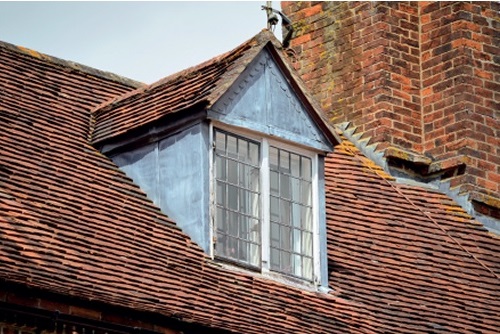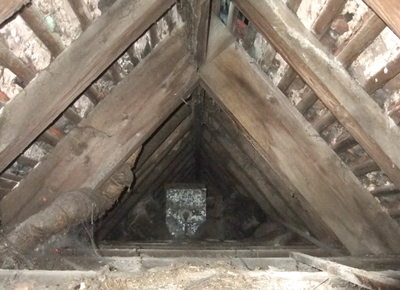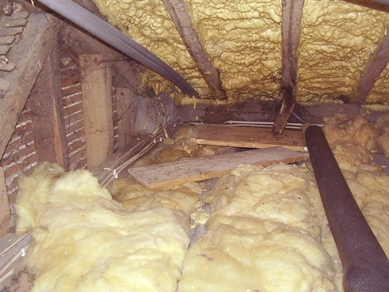Roof Insulation and Ventilation
Jonathan Taylor
 |
|
| Some historic roof details, such as the thin zinc-faced cheeks and gable of this dormer window, are almost impossible to insulate effectively without trapping moisture and causing timber decay. |
High levels of insulation in historic roofs can be counter-productive, resulting in deteriorating historic fabric and even greater heat loss. As in so many aspects of conservation and repair, the principal problems arise from the use of technology designed for modern buildings and a misunderstanding of the way traditional structures work.
WHY INSULATE?
The insulation of roofs is increasingly seen as a necessity, not only to improve the comfort of the occupants of a building and to reduce the cost of heating it, but also as a response to climate change. The existing building stock is responsible for 40 per cent of energy consumption and 36 per cent of CO₂ emissions in the EU. The UK is legally committed to reducing greenhouse gas emissions by 80 per cent from 1990 levels by 2050: most buildings are now required to have an energy performance certificate (EPC), and building regulations have been tightened to improve the performance of new buildings, extensions and refurbishments.
EPCs were introduced by the European Union to provide a measure of a building’s energy efficiency which is rated from A-G, with A being the most efficient. In the UK EPCs are required for buildings when they are built, rented and sold unless they are temporary buildings, workshops, agricultural buildings or stand-alone non-residential buildings of less than 50m². Places of worship in England and Wales are also exempt.
For non-rented buildings EPCs simply highlight deficiencies and there are no requirements for improvements. However, under new energy efficiency regulations most rented properties in England and Wales will be required to have an EPC rating of at least an E by 2018. Unfortunately, the method of calculating the energy performance of traditional structures used is flawed, and many historic buildings actually perform better than their EPC would suggest. A revision of the standard assessment procedure is expected.
Under the Building Regulations, substantial improvements may be required where alterations and extensions require approval. This usually occurs where an existing building is to be substantially renovated or rebuilt, or if a change of use is involved. Building regulations approval is not required for routine maintenance and repair, and listed buildings are exempt from the need to meet energy efficiency requirements where compliance would ‘unacceptably’ alter their character and appearance. (For England and Wales these are listed in Regulation 21.) Unlisted historic buildings in conservation areas may also be exempted from some requirements, but as the insulation of the roof can usually be made without affecting the external appearance, it should be assumed that qualifying works will need to comply.
Whether or not building regulations apply, many owners of historic buildings will chose to improve the insulation of their buildings. Typically around 25 per cent of heat loss occurs through a building’s roof, and roof insulation is generally seen as a relatively easy and inexpensive option, with a good return on investment.
MOISTURE, VENTILATION AND BUFFERING
Moisture sources in a traditionally constructed building include the entire envelope (walls, roofs and floors), internal sources (such as bathrooms and plumbing leaks) and also natural ventilation. It is a common mistake to believe that all ventilation is good – the more the better. Over the past few years there has been a growing body of evidence demonstrating that ventilation needs to be moderated in a climate such as ours, as for much of the year, uncontrolled ventilation admits large volumes of damp air which adds substantially to existing moisture levels in the interior and the fabric of the building.
 |
|
| A mid-19th century roof with neither insulation nor sarking: the roof space is well ventilated and dry, buffered by a high ratio of timber to volume, and warmed by the room below. (Photo: Robert Hill, Historic Building Advisory Service) |
In the simplest structures such as an unheated barn where the slates or tiles are not sealed by sarking or plaster ceilings, interior moisture levels rise and fall pretty much in line with the exterior air, from dawn to dusk and from one season to the next. However, if the ceiling is lined with plaster, as in a church, the reduction in ventilation enables the mass of the walls to moderate the extremes more effectively, contributing to a much more stable environment.
In a building such as a house, where the space is further divided by floors and walls, those elements of the fabric that are porous help to moderate humidity by absorbing water vapour when the relative humidity increases, and releasing it as it lowers, buffering the environment and reducing the likelihood of condensation.
Ongoing research by Historic England (formerly English Heritage) is shedding more light on the humidity-buffering capacity of timber in roof spaces. Brian Ridout, writing in Context in 2014 (see Further Information) demonstrated how, in a traditional roof, the large surface area of wood can absorb excess moisture vapour rising from the rooms below without risk of decay. However, if high levels of insulation are introduced at ceiling level, as is common practice, the temperature of the roof space drops and the relative humidity (RH) increases because cooler air can hold less moisture.
Historic England’s research revealed that buffering is effective at lower RH levels because moisture vapour is absorbed into the chemical structure of cellulose fibres at the surface of the timber and is readily released again as the RH levels fall. However, there is only so much moisture that can be absorbed in this way. If RH continues to rise to 80 or 90 percent, Ridout found that the moisture content of the timber begins to climb at a faster rate, from 16 to 21 per cent.
It is now understood that this is likely to be caused by moisture accumulating as liquid within the pores and spaces, enabling the moisture to penetrate deeper into the timber by capillary attraction. A point may be reached where the timbers no longer dry out readily, and damp levels may then become critical.
INSULATING A PITCHED ROOF
In a pitched roof, insulation is usually introduced in one of three areas: above the rafters so the whole roof structure is warm, below and between the rafters so the roof space itself is warm, or between and above the ceiling joists – the ‘cold roof’ option.
Where a disused building requires total refurbishment, it may be possible to achieve a degree of environmental control that excludes moist air from spaces cooled by the insulation. However, where retrofitting an existing building this is an unrealistic option as an impermeable vapour barrier must be integral, separating the whole of the insulated space from the space below, from eave to eave, in an unbroken plane. In particular, the use of vapour barriers or ‘air vapour control layers’ (AVCLs) on the warm side of the insulation prevent evaporation from the side where evaporation is most likely, trapping condensation.
Current conservation advice from Historic England and Historic Environment Scotland favours the use of vapour permeable insulation materials such as sheep’s wool, hemp, and blown cellulose (made from recycled paper) to avoid trapping moisture in cool spaces. Most lime centres also stock a range of wood fibre boards with good insulation values, some of which are suitable for a lime plaster finish. This approach also enhances the buffering properties of the room.
All these natural materials need to be chemically treated to minimise the risk of fire and insect infestation (clothes moths thrive in poorly treated wool, for example). These materials should not be used in conjunction with AVCLs since this would defeat the object of using vapour permeable insulation. In a ceiling, for example, a well-constructed system of insulation batts, boards and a plaster finish would wick any moisture that condenses in the insulation to the warm surface where it evaporates.
Cold roofs
Where a cold roof is acceptable and the space is accessible, the simplest place to install insulation is between the ceiling joists. Particular attention needs to be paid to the insulation of access hatches and other gaps or thermal bridges, as large uninsulated areas act like an open window, emptying heat from the interior. Problems arise where sections of the ceiling are not accessible, such as dormers and raised ceilings framed by the rafters as a continuous ventilation gap must be left between the insulation and the roof covering.
 |
|
| Foam sprayed on the underside of the roof tiles blocked all ventilation, while the insulation at ceiling level has created a cold roof, so the timbers now suffer from damp problems. (Photo: Robert Hill, Historic Building Advisory Service) |
Lights set into the ceiling pose another problem, presenting a potential fire hazard when covered by insulation. LED fittings with a low heat output may be the answer. High voltage cables will need to be re-run above the insulation for the same reason.
Closed-cell insulation batts should never be used between joists or rafters as they trap moisture at the interface with timber.
Warm roofs
Where a warm roof is required, it is usually possible to install all the insulation required within the depth of the rafters while leaving a clear ventilation gap of at least 50mm below their upper edge. However, for rafters of less than 200mm (dormer roofs for example) it may be necessary to fix insulation boards to the lower face of the rafters.
It is important to maintain a permanent ventilation channel of at least 50mm between the insulation and the underside of the battens or sarking. If the roof has been lined with a breather membrane, the insulation could be soaked if it comes into contact with the material during a storm. If the ventilation channels are separated from the roof tiles by impermeable sarking (closed sarking boards or bituminous felt), through ventilation from the eaves to the ridges may be achieved with minimal visual impact by raising the ridge capping slightly.
To ensure that the insulation does not impinge on the ventilation channel, semi rigid batts may be used, held in place by battens fixed to the sides of the rafters 50mm or so below their upper edge. The insulation batts need to be cut to form a snug fit, and then lined with plaster board or wood fibre boards.
If the roof covering is being relayed, it may be possible to introduce some insulation above the rafters, with the existing roof covering reinstated on new battens fixed though the insulation into the rafters. From a structural perspective this is the safest place as all the structural elements are kept warm, but it is difficult to protect a breathable insulation batt in this position from wind-driven rain, and the increased height of the tiles or slates may be unacceptable visually. One option is to use a breathable multi-layer quilt of perforated foil with fibrous insulation between the rafters below.
BEST PRACTICE
Historic buildings vary widely in their form and construction, and a solution which is suitable in one situation may be unsuitable in another. It is therefore important to consider all possible consequences and proceed with caution. Key issues to bear in mind when developing a solution include:
Reversibility Any solution should be removable without damaging the original fabric in the process. Spray-on insulation foams, for example, are not reversible, preventing the reuse of the roof slates or tiles. (They also trap moisture and can be highly damaging.)
Effects of cooling The design of the insulation measures needs to take into account the risks of condensation on the cool side. Some heat loss may be necessary to prevent condensation and decay, and it may not be possible to achieve insulation levels comparable with that of a modern building.
Buffering Traditional materials such as plaster, masonry and timber help to moderate humidity levels provided that they are not coated with an impervious paint. Buffering potential can be increased by the introduction of appropriate fabric where needed.
Moisture ingress Maintenance of the roof covering, flashings and gutters becomes even more important when a roof has been insulated, as moisture tolerances may be stretched. Maintenance lower down the building is also critical, such as plumbing leaks and poor pointing, and bathrooms and kitchens require extractor fans to expel moist air, preferably with a both a humidity sensor and a timer.
~~~
Further Information
English Heritage, Practical Building Conservation: Building Environment, Ashgate, Farnham, 2014
English Heritage, Practical Building Conservation: Roofing, Ashgate, Farnham, 2013
Historic Scotland, Fabric Improvements for Energy Efficiency in Traditional Buildings, Edinburgh, 2013
B Ridout, ‘Ventilation and Timber Decay’, Context 134, IHBC, May 2014



